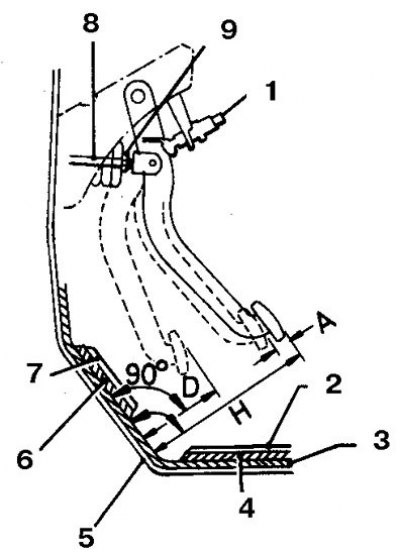Pedal Height Measurement

1. Stop signal switch; 2. Mat; 3. Waterproofing layer; 4, 6. Anti-noise coating of the partition; 5. Gender; 7. Mat; 8. Pusher; 9. Locknut; A. Free running; D. Pedal height; H. Pedal release height
Adjustment
1. Measure the distance from the pedal to the floor.
2. If necessary, remove the lower front panel from the driver's side (see subsection 13.26).
3. Remove the pad in the area of the driver's feet, disconnect the latches and remove the carpet, opening access to the hatch in the anti-noise floor covering.
4. Remove the sunroof and check the pedal height.
5. Compare with standard value.
6. If necessary, adjust the pedal as follows.
7. Loosen the pusher locknut and rotate the pusher to set the desired pedal height.
8. Tighten the locknut to the specified torque.
9. Check the free play of the pedal, which is equal to the movement of the pedal until you feel a slight resistance to its movement.
10. After releasing the pedal, the brake light should go out.
11. Otherwise, replace the switch (the switch is mounted on the pedal bracket with a bayonet connection and is not adjustable).
12. Start the engine and at idle check the pedal height.
13. If the height is less than normal, then the brakes are faulty.
14. In this case, replace the fluid in the hydraulic drive and remove the air.
15. If this measure does not work, then check the condition of the master and wheel cylinders.
16. Install all removed panels when finished.
Removing
1. Remove the lower front panel from the driver's side.
2. Unpin and remove the axle, check the condition of the axle.
3. Disconnect the wires from the brake light switch.
4. Remove the four nuts securing the pedal bracket to the bulkhead (the vacuum booster is also fastened with the same nuts).
5. Turn away the top bolt and remove a pedal with an arm.
6. The brake pedal is made together with the bracket and does not change separately.
Installation
1. The pedal is installed in reverse order.
2. Check pedal adjustment.